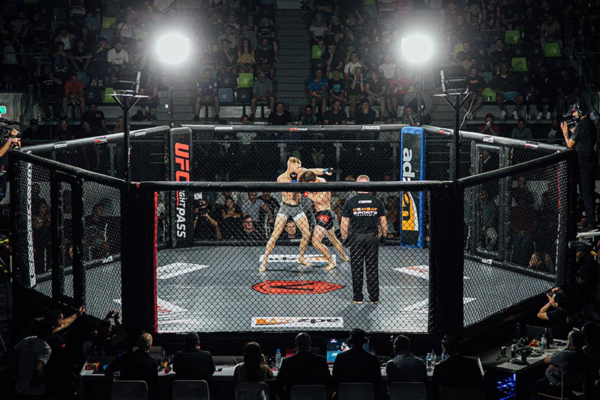MMA rules: From chaos to discipline

Mixed Martial Arts (MMA) has grown into one of the most popular and dynamic fighting sports in the world. What once started as an unregulated fight between different fighting styles is now a sport with a clearly defined set of MMA rules. Yet many people do not understand how these rules came about and why they are so important.
The origin of MMA and the need for rules
The first form of MMA as we know it today emerged in the 1990s with the rise of the UFC. These early tournaments were known for their brutal nature, pitting fighters from different disciplines against each other with few restrictions. The idea was simple: which fighting style is most effective in a real fight?
Criticism of this form of fighting soon arose. Politicians, sports organizations and media called it barbaric and demanded a ban. In some states of the United States, MMA was even declared illegal. This forced the organizers to think about rules that could make the sport safer and more professional.
The evolution of MMA rules
In order to save MMA and make it acceptable to a wider audience, the “ Unified Rules of MMA ” were introduced in 2001. This laid the foundation for how the sport is practiced today. Weight classes were introduced, clear guidelines on what techniques were allowed and referees were given the task of ensuring the safety of the fighters.
These changes not only made the sport safer, but also caused MMA to evolve into a more strategic and technical game. Fighting styles began to blend and fighters had to develop all-round skills to win within the new rules.
The rules of striking
Striking is one of the most spectacular parts of MMA. Fighters are allowed to hit their opponents with punches, kicks, knees and elbows, but within certain limits. For example, a fighter is not allowed to kick the head of a lying opponent and punches to the back of the head are also prohibited.
Additionally, a specific elbow technique known as the 12-to-6 elbow is banned. This is a downward elbow motion in which the arm moves vertically from top to bottom, as if the hands of a clock are going from 12 to 6. This technique was banned due to concerns about the impact and potential for serious injury, though many fighters and fans find the ban controversial.
The rules of grappling and submissions
When a fight goes to the ground, the game changes completely. This is where wrestling and Brazilian Jiu-Jitsu come into play. Fighters are allowed to lock their opponent down with submissions such as armlocks and chokes. If a fighter can’t defend, they can tap to end the fight.
While ground fighting can be hard to follow for new fans, the rules ensure it remains a fair part of the sport. The referee can intervene if a fighter is locked in a submission and can no longer respond, preventing serious injuries.
Illegal techniques, where do we draw the line?
Despite MMA being known as one of the most complete combat sports, there are clear limits to what is allowed. Kicking the head of a prone opponent, biting, eye poking and holding the cage are prohibited techniques that can lead to a warning or disqualification.
These restrictions ensure that MMA does not become a chaotic fight, but remains a regulated and fair sport. By maintaining the balance between freedom and safety, fighters can show their skills without taking unnecessary risks.
The role of the referee
The referee plays a crucial role in an MMA fight. He or she must keep a close eye on the fight and intervene when necessary. This can be done by stopping a fight if a fighter is knocked out, can no longer defend himself or is locked in a submission from which he cannot escape.
This role of the referee keeps the sport exciting, but also safe. Without strict enforcement of the rules, the chance of serious injuries would be much greater and MMA would never have become the professional sport it is today.
Decisions and controversies in MMA
Sometimes the role of the referee is a subject of debate. Decisions such as an early or late stoppage can affect the outcome of a fight. Fans and fighters do not always agree with the way a referee intervenes, which often leads to controversy in the sports world. Nevertheless, the referee remains an essential part of the sport. The right decision can protect a fighter from permanent injury, while the wrong decision can have serious consequences for someone's career.
The latest updates in 2024
The MMA rules continue to evolve, with changes made each year to make the sport fairer and safer. In 2024, some major changes were implemented, including stricter enforcement of kicks to the head of a prone opponent. The judging process was also changed, reducing the weight of takedowns that do not cause direct harm.
In addition, there are new guidelines for medical check-ups and recovery periods after a knockout. This should ensure that fighters do not return to the cage too quickly after a heavy blow, which will benefit their long-term health.
What do you think the next big change in MMA rules will be?
Join the Fightstyle Family!
Want to experience the sport yourself or support your favorite fighter? Fightstyle offers high-quality MMA gear and accessories for beginners and professionals alike.
 Nederlands
Nederlands English
English Deutsch
Deutsch Français
Français


Interessant stuk!!. Vooral dat deel over de evolutie van de regels vond ik boeiend, grappig om te bedenken dat mma ooit echt bijna “alles mag” was.
Leave a comment